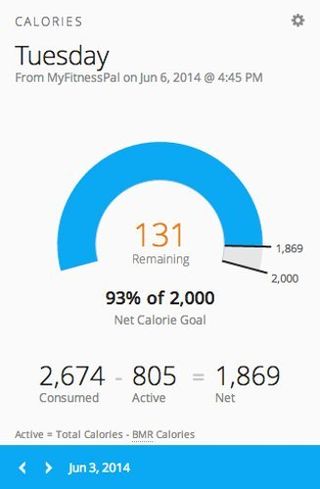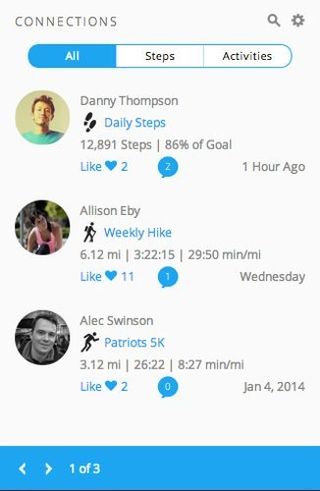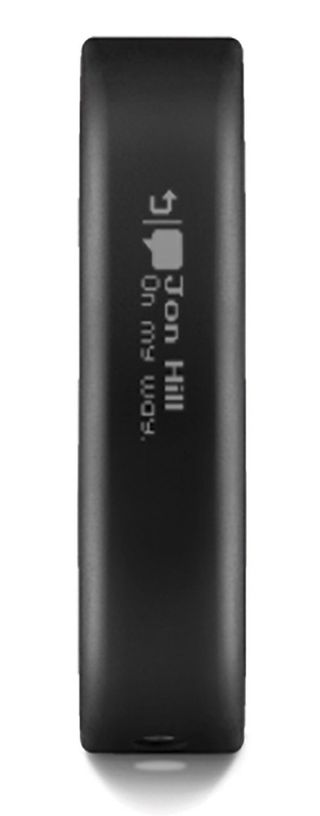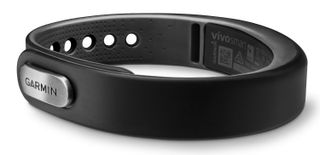Garmin Vivosmart Review
The Garmin Vivosmart wristband marries accurate activity tracking with smartphone notifications in a comfortable, minimalist design.
Why you can trust Tom's Guide

Plenty of companies are trying to bridge the gap between fitness trackers and smartwatches, and Garmin believes it has the answer. Starting at $169, the Garmin Vivosmart wristband tracks steps, calories, movement and more while delivering smartphone notifications to your wrist via its OLED display. Could the Vivosmart be the hybrid to beat?
Design
I would describe the Garmin Vivosmart's design as muted sporty. Unlike the Basis Peak's smartwatch-esque design, the smooth, black Vivosmart wristband is understated yet chic, becoming slightly thicker by the OLED screen. Fastening the rubber clasp is slightly cumbersome, and one end is garnished with a silvery, raised Garmin logo. If you don't want an all-black wristband, you can personalize the Vivosmart by choosing an underside color of mauve, violet, dusty blue or gray.

The discreet display is where the Vivosmart really shines. Double-tap the 1.35 x 0.14-inch, 128 x 16 resolution display to reveal the time and date. Swiping left or right lets you view notifications, music controls, miles walked, calories burned, step goal, steps taken and the "time to move" bar. This bar keeps track of how long you've been inactive and will remind you to move every once in a while with short, vibrating notifications.
MORE: Best Fitness Trackers
Compared to the Samsung Gear Fit and the Fitbit Charge, the Vivosmart shows you more pieces of activity data on its display — both the Gear Fit and the Charge rely on steps, distance and calories burned, although the Charge does show you floors climbed and active minutes.
The Vivosmart's display was easy to view in sunlight, and perfect in indoor environments. While it's not the vibrant AMOLED, 432 x 128-pixel display of the Samsung Gear Fit, it did a fine job of displaying and letting me interact with notifications. The swipe gestures are fluid, but sometimes I found myself double-tapping the screen over and over without a response. It takes a specific rhythm to wake the Vivosmart's screen, and in terms of conserving battery life, it's probably for the best.
Setup
Getting started with the Garmin Vivosmart is fairly simple — download the Garmin Connect app for iOS or Android, and you'll be asked to sign in or create an account. Then, you'll have to search for the Vivosmart in Garmin's list of devices (Garmin Connect isn't exclusively for the Vivosmart), select it and pair your device with the app. It takes a minute or two for the app and the device to totally sync up via Bluetooth.
App
Garmin Connect is used for many of Garmin's wearable devices, and as health apps go, it's completely inoffensive, albeit boring. You'll spend most of your time on the home screen, where you can see all the activity the Vivosmart has tracked over the course of the day, and days past.

Every time you open the Garmin Connect app, it syncs with your Vivosmart and populates with the day's data — unlike the Fitbit Charge, which promises to constantly sync your wristband's data to the app in real time. Garmin Connect organizes all of your activity data into cardlike sections: Steps, Calories, Sleep, Weight, Badges, Activities, Segments, Personal Records, Courses and Workouts. I personally took most notice of the Steps, Badges and Activities cards because I wanted to see how far I walked every day, as well as the badges I earned for taking thousands of steps.

I would have liked to see a few more activity options to add, though. Currently, the Activities card lets you log running, cycling, walking, fitness equipment, hiking, swimming and transition exercises, but there is an "other" category, which I used for my frequent elliptical sessions.

Quite a few of the Garmin Connect's features connect to other apps as well, though not Apple's HealthKit. You can log in to your MyFitnessPal account in the Calories card to track your food intake, and Courses and Workouts lets you view and follow exercise plans you've created on garminconnect.com.
If you're competitive when it comes to exercising, you can use the Community page to connect with friends who have Garmin activity trackers, and receive news from their latest workouts, compete in step challenges, and create and join groups.
Notifications
The Garmin Vivosmart connects to Bluetooth 4.0-compatible smartphones, so you can get all your notifications — including text message, email, Twitter, Facebook, Instagram, Snapchat and others — on the wristband. Its variety of notifications puts it on a par with the Gear Fit, and ahead of the Fitbit Charge, which supports only call notifications. I found the Vivosmart's short vibration and text notifications to be accurate and superfast — sometimes, my Vivosmart vibrated to notify me of a text message before my iPhone even buzzed.

Overall, the Vivosmart's notifications did what they were supposed to do: help me not look at my phone as much. When my wrist vibrated with an email notification, I looked down and immediately knew if my attention should switch to that email, or if I could let it slide. For example, when I received email alerts, the Vivosmart showed me the sender and the first line of the message, and then I could tap on the down arrows on the side of the notification to read the full message. You could potentially read a full email on the Vivosmart's tiny display, but I wouldn't recommend it.

Other notifications, such as those for Instagram and Facebook, were much shorter messages detailing a like or a new friend request. Basically, the Vivosmart helped me decide whether it was worth my time to pick up and look at my phone.
MORE: Best Smartwatches
However, you can't dismiss notifications from the Vivosmart's display; you'll have to use your smartphone. That's the only big difference between the Vivosmart's notifications and Samsung's Gear Fit, which lets you dismiss notifications from its screen.
Sometimes, the Vivosmart got overzealous with notifications. The only way to remedy this is to edit which types of notifications you receive on your smartphone — you can't do this right from the Vivosmart.
Since the Vivosmart is constantly connected to your smartphone via Bluetooth, it will vibrate to let you know when you're out of reach of your smartphone, thus losing the Bluetooth connection. This meant my wrist would vibrate every time I left my iPhone on my desk to walk to another part of the office. The Vivosmart vibrated once to show me the connection was lost, and once to show me the connection had been restored when I sat back down.
Performance
The Garmin Vivosmart accurately tracked my steps from the second I put it on. After using it for nearly a week, I noticed the average number of steps I took on a regular workday, and the difference between workdays and weekend days, when I was either out and about with friends or being lazy at home and not moving much.
During my lazy moments, the Vivosmart consistently provided "Move!" reminders every hour, encouraging me to get off the couch and walk for a little bit. However, I did wish I had a more accurate way to track my daily workouts, rather than just inputting them myself.

While I did use the Vivosmart as a sleep monitor, I wouldn't put too much stock in it. Like the Samsung Gear Fit, the wristband tracks movement while you're asleep, equating a good night's sleep to a night of slumber with little to no movement. Movement is only one factor that goes into accurately monitoring and assessing sleep quality, so I won't be turning to the Vivosmart to tell me how to sleep better.
You also have to put the Vivosmart into sleep mode by pressing the display and choosing the moon icon from the settings list. This is similar to the process that puts the Gear Fit into sleep mode, but it requires a little more work than the Fitbit Charge, which claims to automatically detect when you're going to bed.
As on the Fitbit Charge, the Vivosmart has a sleep alarm, so you can wake up to the wristband's vibrations. This feature worked for me — and it's a feature that the Gear Fit doesn't have — but I barely felt the vibrating alarm in my deep sleep. I would be wary about having the Vivosmart's vibrating alarm as my only alarm.
Battery Life
Garmin claims that the Vivosmart can get up to seven days of battery life, with 24/7 monitoring, on a single charge. I used my Vivosmart for four days, and the battery was still going strong, showing about 65 percent left on the meter. You'll get way more use from the Vivosmart in one charge than you will from the Samsung Gear Fit, considering that wristband drained to nearly 30 percent after just two days of moderate use. We'll have to see how the Garmin compares to the Fitbit Charge, which is also expected to get seven days of battery life on a charge.
Configurations
The Garmin Vivosmart wristband starts at $169 for the basic model. You can get a Vivosmart with an optional heart-rate monitor chest strap, which will cost you $199.
Bottom Line
For people who are serious about moving more, and looking to distance themselves from their smartphones, the Garmin Vivosmart is a solid device for its $169 price. Whereas the Samsung Gear Fit takes a backseat to fitness tracking, the Vivosmart easily and accurately tracks steps, distance and overall movement each day. Also, the ability to read all your notifications on the Vivosmart's OLED display could improve your relationship with your smartphone — and make your life a little bit easier in the process. Although it doesn't monitor your heart rate, the Vivosmart is certainly an intelligent activity tracker made even more intelligent with smartphone integration.
- 15 Best Fitness Apps
- Fitness and Health Gadgets: Tracking Your Life
- Latest Fitness Tracker News and Reviews
Follow Valentina Palladino at @valentinalucia. Follow Tom's Guide at @tomsguide and on Facebook.
Sign up to get the BEST of Tom’s Guide direct to your inbox.
Upgrade your life with a daily dose of the biggest tech news, lifestyle hacks and our curated analysis. Be the first to know about cutting-edge gadgets and the hottest deals.
Valentina is Commerce Editor at Engadget and has covered consumer electronics for a number of publications including Tom's Guide, Wired, Laptop Mag and Ars Technica, with a particular focus on wearables, PCs and other mobile tech.

